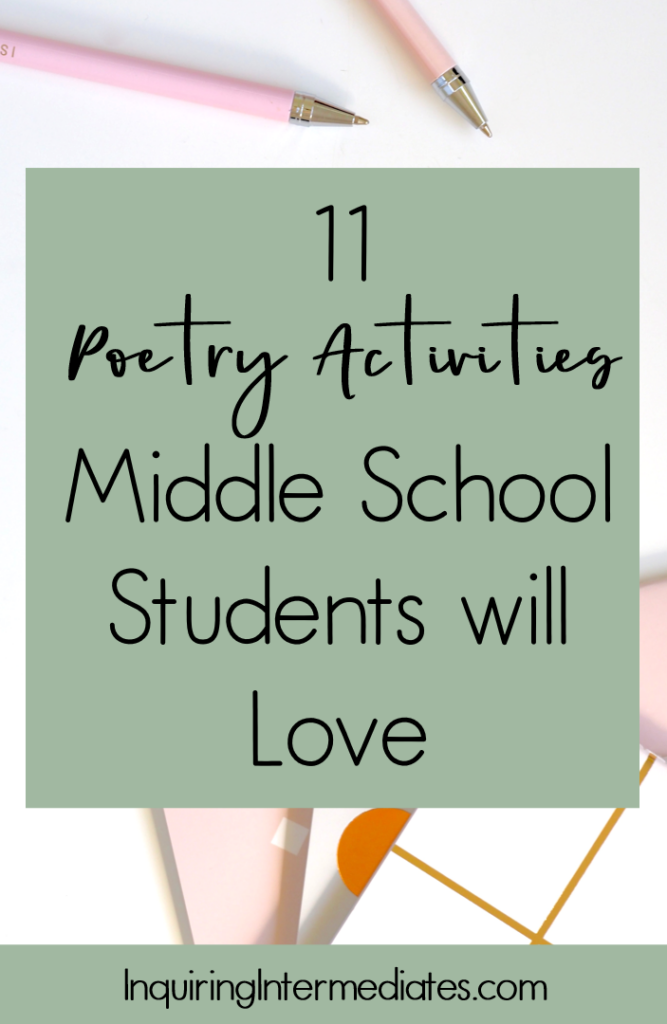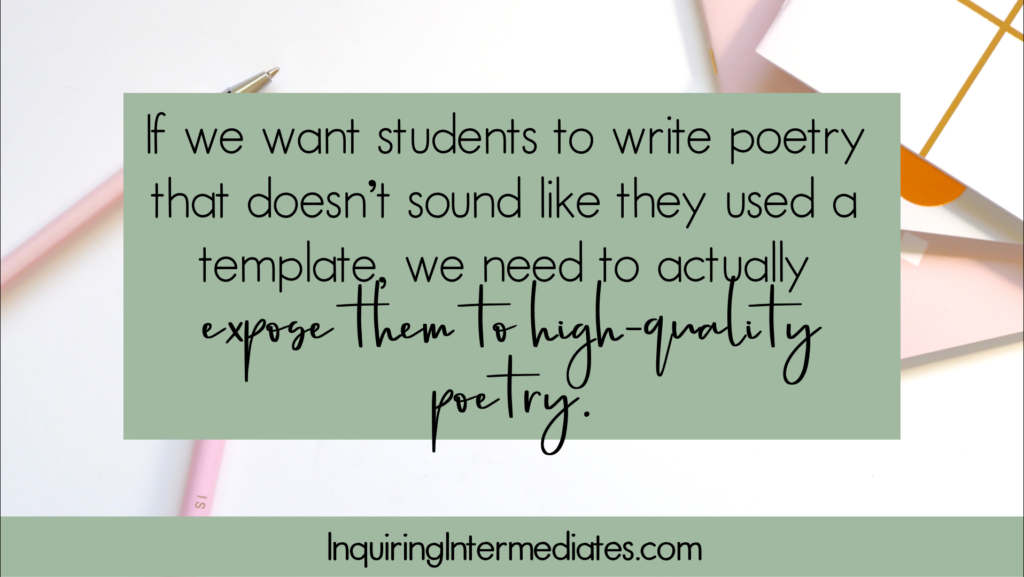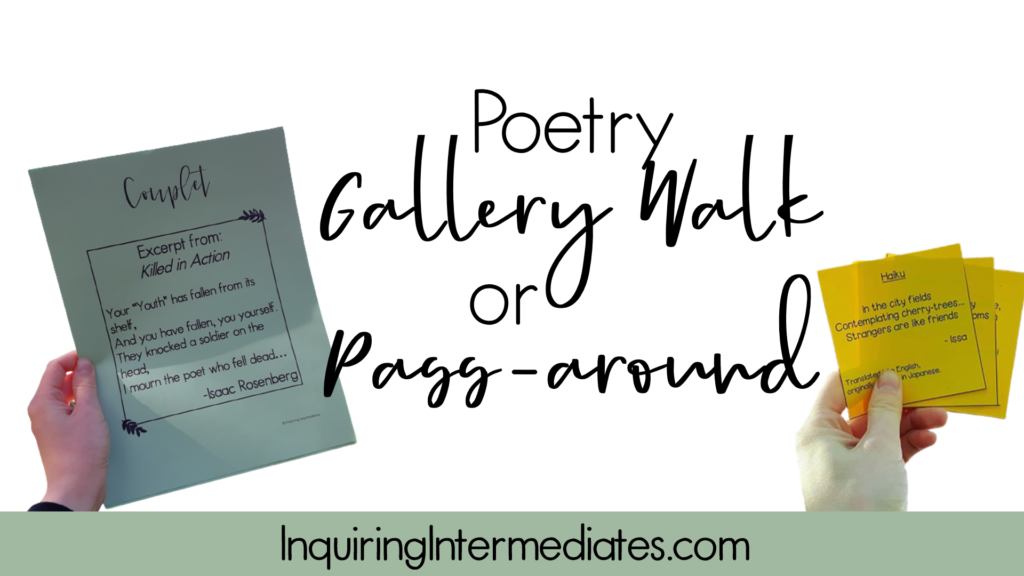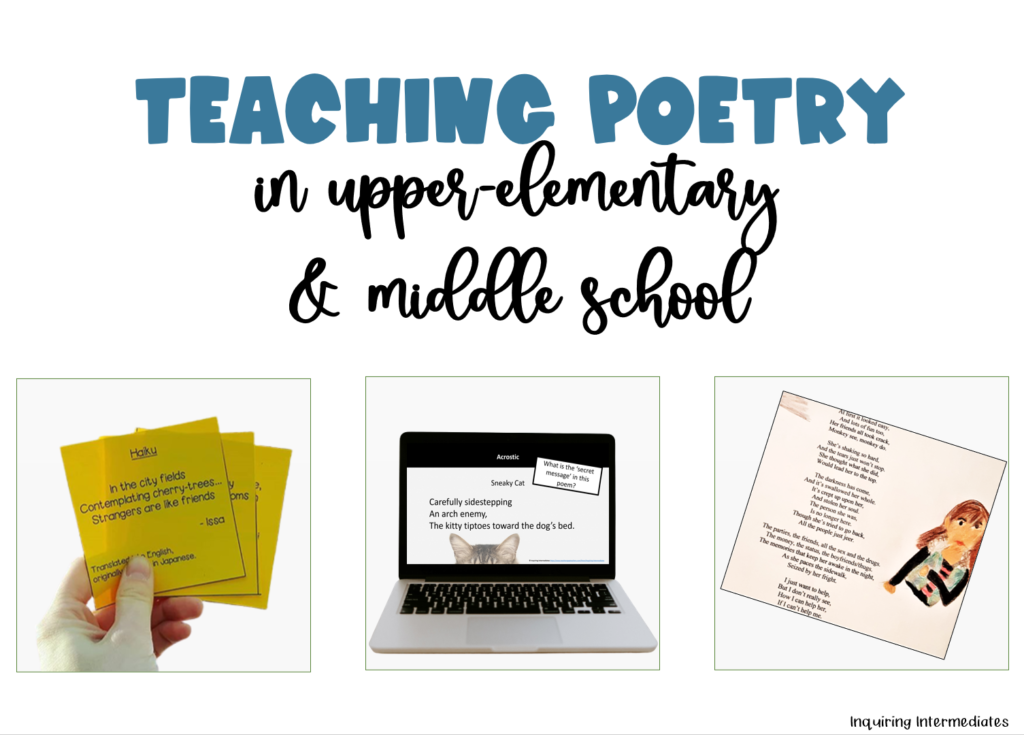Did you know April is National Poetry Month? I’m so excited for it. I love, love, love poetry, and I want your middle schoolers to love it too! Writing poetry got me through some tough times as an angsty middle schooler and teen, so I always look forward to exploring poetry with my students. I hope some of these poetry activities for middle school will help you get excited about teaching poetry to your students too!
Outdoor Poetry Activities for Middle School
Learning is always more fun in the sun! Here’s a super simple outdoor writing activity you can use with your class on the next sunny day. Take students outside and challenge them to pick one thing that they think is beautiful (and yes, it should be a thing, not a person…). Get them to describe that item with the most vivid language possible. You could also challenge them to use only figurative language. Later, have them to pick their favourite phrases and build a poem around them.
If you’re teaching students how to write haikus, there’s no better place to be than in the great outdoors! Traditionally, haikus are written about nature, which makes this lesson the perfect opportunity for outdoor learning. I have this vision of finding a cherry blossom tree near my school and getting my students to sit around it as they write some haikus…

Half the fun of writing poetry is getting to share it. Have your students make a poetry walk on the school grounds with sidewalk chalk. Give them all a section of the sidewalk and let them write one of their favourite poems! For this activity, shorter poems like couplets and haikus are generally better. They’re easier for people passing by to read, and they’re easy to write with fat pieces of chalk.
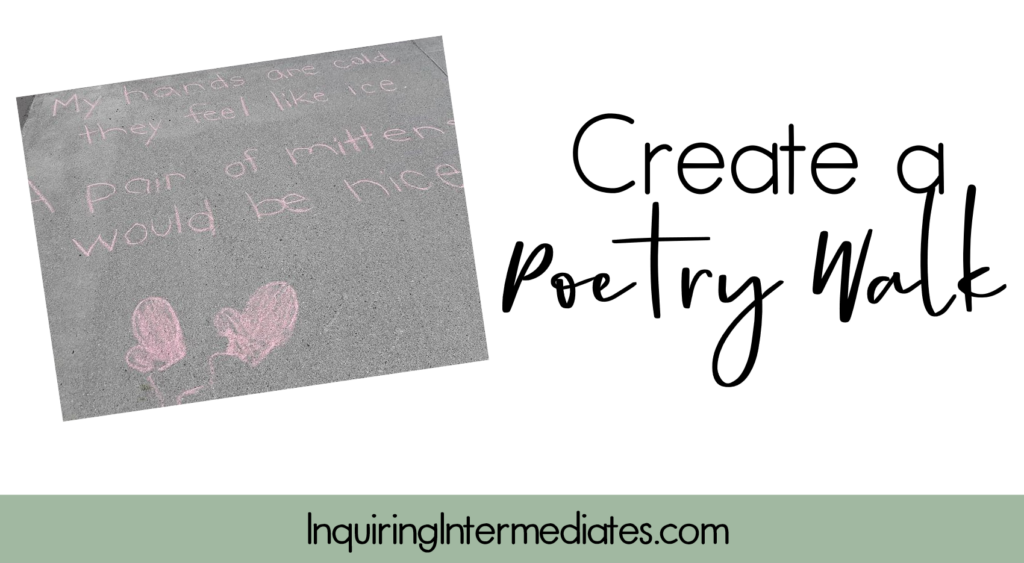
Teaching Rhyme or Structure
Games for Teaching Rhyme
Rhyme Challenges are one of the easiest poetry activities middle school teachers can use to help students practice rhyme. Put a one-syllable word up on the board, break students into groups, and challenge them to come up with as many rhyming words as possible. Then, as a class, take some time to share all the words students brainstormed. To make this into a competition, coordinate with another teacher so your classes can compete
One thing to note: many students will find that coming up with multisyllabic rhymes are difficult. If you want to incentivise them to think out of the box, tell them each syllable is worth one point! These challenges are a great opportunity to model how you come up with rhymes. Personally, I do a mental run-through of the alphabet. For example, if I’m rhyming with “cat”, I’d think bat, chat, drat, fat, etc.
Around the World is another one of those fun poetry activities middle school students will love. Begin by having all but one of the students sit in their seats. That one student stands behind a classmate. This is the starting point. On the count of three, the teacher calls out a word. The student who is standing and the student sitting in front of them both try to think of a word that rhymes. Whoever comes up with one first gets to move on and stand behind the next student. The person who loses this round sits in the seat, whether that means they stay where they were seated or trade places with the person they were standing behind. The challenge is to see if any students can make it ‘around the world’ (around the classroom and back to the seat they started in).
Buzz In: A Game for Poetic Structure
If you’re teaching a poetic structure with rules, like limericks or haikus, here’s a fun way to practice them. I call it Buzz In, but it’s really just gamified collective writing. Start off by picking a particular poetic form. For this example, let’s go with limericks. Choose three or four students to come up to the front and give each one buzzers or some way to signal when they’re ready.
Tell students the first line of the poem they’ll be “playing”. For this example, let’s start with – “There once was a girl whose name was Ann.”
The first student to buzz in and share a second line gets to stay in the game. Perhaps they say something like, “who played in an angry rock band.” The students who did not buzz in first return to their desks.
- Call three more students up. Recite the two lines of the poem as it currently stands.
- Whoever buzzes in first with the next line gets to stay. The others return to their desks.
- Continue until the poem is complete.
- See if students can break the class record for staying in the game for the most rounds!
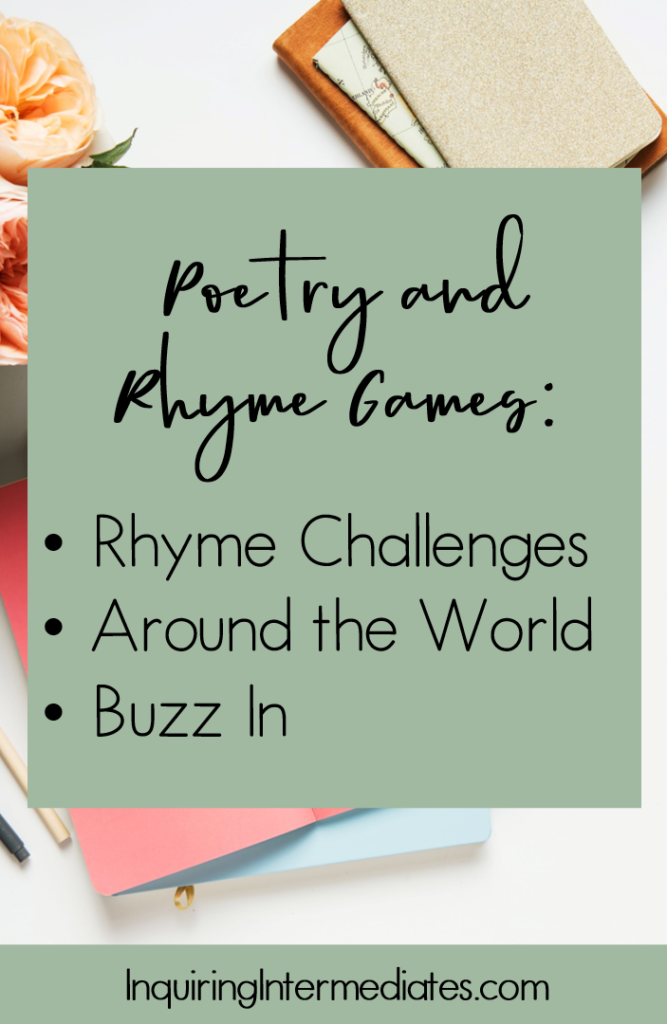
Analyzing Poetry Activities
Poetry Puzzles
Give students the first line of the poem they’ll be “playing”. Let’s say we start with – “there once was a girl whose name was Ann.”
- The first student to buzz in and share a second line gets to stay in the game. Perhaps they say something like, “who played in an angry rock band”. The other three return to their desks.
- Call three more students up. Recite the two lines that you have now (yours and the one from the student who won the last round).
- Whoever buzzes in first with the next line gets to stay, and the others return to their desks.
- Continue until the poem is complete.
Cross-Curricular Poetry Analysis
If you teach multiple subjects, consider tying poetry into a math unit on patterns. Patterning and rhyme schemes go hand in hand! You can even tie in math, poetry, and art, by having students represent the rhyme scheme of a poem in a visual arts piece.
Another way you can make your poetry unit cross-curricular is by having students represent a poem through dance, drama, visual arts, or music. Students could come up with a short skit that showcases an event they think may have inspired their chosen poem. They could also create an illustrated poetry anthology. I have criteria and rubrics available for a poetry anthology project here.
If you’re looking for guaranteed buy-in for your middle school poetry unit, bring in some music by sending students on a Music Hunt! Get them to look for songs that have examples of specific literary devices or follow a particular rhyme scheme. Let them play the song for their classmates (as long as it’s school-appropriate, of course), and demonstrate how it fits the criteria.
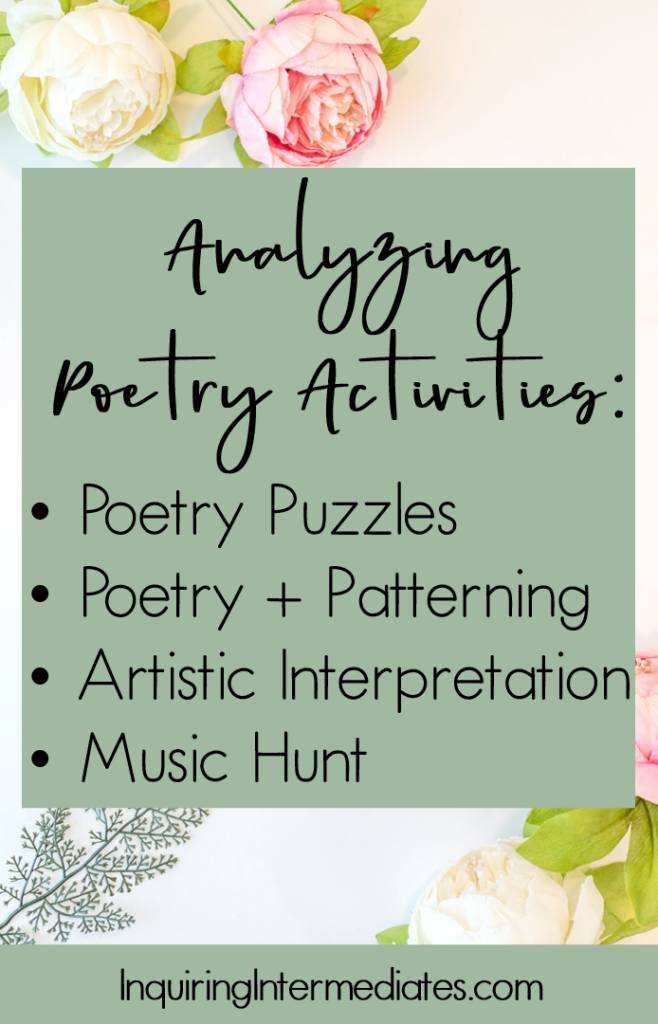
Poetry Books for Middle School
Introduce your students to the world of free verse poetry! It’ll blow the minds of kids who were raised to think Cat in the Hat was the height of poetic sophistication. Here are some free verse poetry books middle school students will love:
- Inside Out and Back Again by Thanhha Lai
- Forget Me Not by Ellie Terry
- Other Words for Home by Jasmine Warga
- Anything by Kwame Alexander
- Here Was Paradise by Humberto A’kabal
All of these books are fantastic #ownvoices texts and make perfect read aloud poetry novels for middle school (with the exception of the last one, which is a beautiful bilingual collection). They would also make fantastic book club or literature circle texts!
Looking for something shorter? Try out Can I Touch Your Hair? Poems of Race, Mistakes, and Friendship. It’s a picture book written from the perspectives of a white girl and Black boy who are paired together for a poetry project… what a great anchor text for a poetry unit!
Just because you’re teaching big kids, it doesn’t mean that you have to ditch your rhyming picture books! Older kids enjoy a just-for-fun read aloud too. You can totally use simple poetry books for middle school lessons. Make your students work a little by pausing as you read and getting them to shout out their rhyme predictions. Some of my favourite go-to books for rhyme predicting are Thelma the Unicorn, The Girl Who Thought in Pictures, and The Doctor with an Eye for Eyes. If you want to be extra tricky, you can cover the rhyming words with sticky notes.
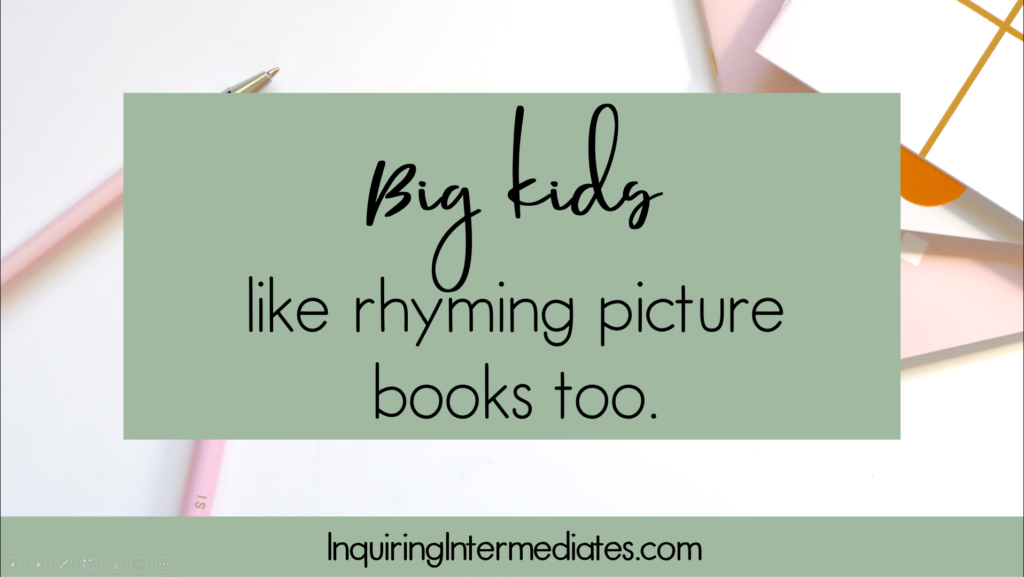
Poetry Activities as Morning Work
If you’re into morning work, try some of these poetry warm up activities!
- Free verse can be daunting for young writers who are used to thinking of poetry as words that rhyme. It’s almost like they’re intimidated by the lack of structure! Attempting it in small, manageable chunks with familiar topics makes it much less scary. For example, you might have students write a free verse poem about their happy place as a morning work activity.
- Finish This: Begin by putting part of a poem on the board; it can be one you made up or something you found online or in a book. Challenge students to come up with the rest of the poem, then take some time to let volunteers share their completed poems with the class. It’s so neat to see all the different ways students run with the same text!
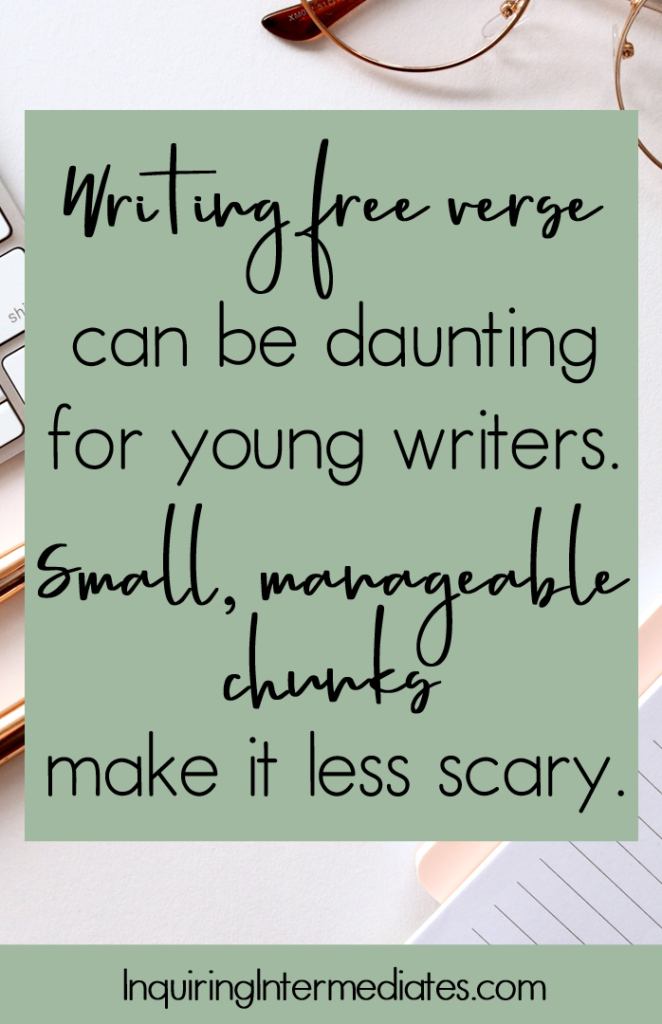
Poetry Teaching Activities: Gallery Walk or Pass-Along
Middle school students are old enough to stretch themselves when it comes to poetry. We can start expecting them to move away from basic rhymes. And, for the love of all things literary, we can ditch those horrid “I Am” poems. Any poem that works as a fill-in-the-blank is not going to stretch your students as writers.
If we want students to write quality poetry that doesn’t sound like they used a template, we need to actually expose them to high-quality poetry. We need them to know that poetry can take many different forms. Here’s the thing, even the best poets in the world are not going to excel in every poetic form… and that’s OK. When teaching poetry, I think it’s important to let students experiment with a bunch of different poetic forms so they can find what makes their hearts sing.
This is where one of my favourite poetry teaching activities comes in: poetry gallery walks! This set of poetry gallery walk posters features example poems for nine different poetic forms. Before I introduce a new poetic form, students can go on a poetry gallery walk to explore some examples. I always like to see if they can figure out the ‘rules’ of the poetic form as they go.
Students move at their own pace and don’t have to read all the examples, but they should read at least a few. Afterward, we debrief by talking about what the poems had in common and what made them different. We share favourite lines and see if anyone has questions or comments they’d like to share about the meanings of or words in the poems. I like this structure because it makes the students do the work of figuring things out on their own rather than just listening to me tell them the ‘rules’.
If space is limited in your room, see if you can use space in the hallways or outside for your gallery walks! I often do mine outdoors; our portable is magnetic, so I just stick the posters in whiteboard pockets and hang them up with magnetic whiteboard clips. However, if space isn’t available, you can also do a poetry pass-along with these little poetry cards (see below)!
Looking for more poetry teaching ideas for middle school or upper-elementary?
If so, check out this blog post that outlines how to structure a middle school poetry unit!
Want to remember these poetry activities middle school students will love? Pin the imge below to save them for later!
